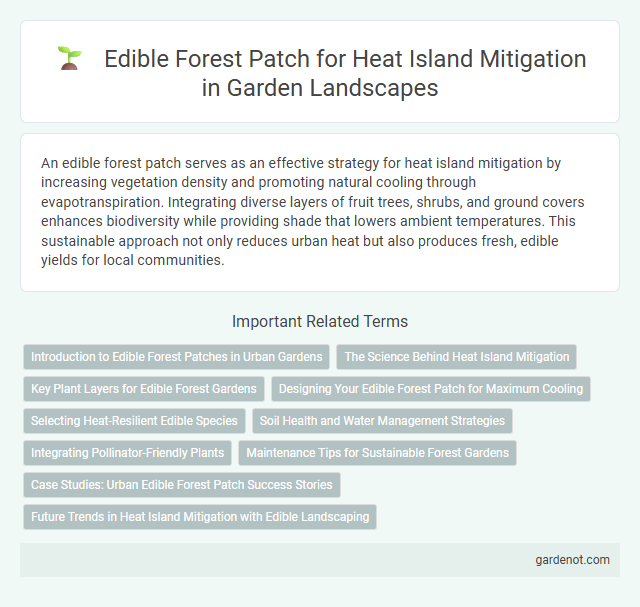An edible forest patch serves as an effective strategy for heat island mitigation by increasing vegetation density and promoting natural cooling through evapotranspiration. Integrating diverse layers of fruit trees, shrubs, and ground covers enhances biodiversity while providing shade that lowers ambient temperatures. This sustainable approach not only reduces urban heat but also produces fresh, edible yields for local communities.
Introduction to Edible Forest Patches in Urban Gardens
Edible forest patches in urban gardens integrate diverse layers of fruit trees, shrubs, herbs, and perennials to create a self-sustaining ecosystem that enhances biodiversity and promotes local food production. These patches contribute to heat island mitigation by increasing canopy cover, improving soil moisture retention, and reducing surface temperatures through evapotranspiration. Incorporating native edible plants further supports urban wildlife while providing nutritious, seasonal harvests for communities.
The Science Behind Heat Island Mitigation
Edible forest patches play a critical role in heat island mitigation by increasing urban canopy cover, which significantly reduces surface and air temperatures through shading and evapotranspiration. Research shows these densely planted, multi-layered green spaces enhance urban microclimates by lowering ground heat absorption and promoting cooler ambient conditions. Studies also highlight that integrating edible plant species supports biodiversity while improving thermal comfort in heat island-affected neighborhoods.
Key Plant Layers for Edible Forest Gardens
Key plant layers in edible forest gardens include the canopy, understory, shrub, herbaceous, ground cover, root, and vine layers, each contributing to biodiversity and microclimate regulation. Canopy trees provide shade and reduce heat island effects by lowering surface temperatures, while understory and shrub layers enhance air humidity and soil stability. Incorporating diverse edible species within these layers optimizes photosynthesis, water retention, and nutrient cycling, essential for effective heat island mitigation in urban yards.
Designing Your Edible Forest Patch for Maximum Cooling
Designing your edible forest patch for maximum cooling involves layering diverse plant species to create dense foliage that shades the soil and reduces surface temperatures. Incorporate fruit trees with broad canopies, understory shrubs, and ground covers to enhance evapotranspiration and promote natural airflow. Selecting native, drought-tolerant plants ensures resilience while optimizing the microclimate to mitigate urban heat island effects.
Selecting Heat-Resilient Edible Species
Selecting heat-resilient edible species for an edible forest patch enhances its ability to thrive in urban heat island environments by maintaining productivity and biodiversity. Species such as moringa, pigeon pea, guava, and amaranth exhibit strong tolerance to high temperatures and drought conditions, making them ideal choices. Incorporating these heat-adaptive plants reduces water requirements and supports sustainable food production while mitigating local temperature extremes.
Soil Health and Water Management Strategies
Edible forest patches enhance soil health by promoting organic matter accumulation and microbial diversity, which improves nutrient cycling and soil structure. Deep-rooted perennial plants in these patches increase water infiltration and retention, reducing surface runoff and erosion. Incorporating mulch and companion planting further optimizes moisture conservation and supports sustainable water management in heat island mitigation yards.
Integrating Pollinator-Friendly Plants
Integrating pollinator-friendly plants in an edible forest patch enhances biodiversity by attracting bees, butterflies, and other essential pollinators, which improves fruit and vegetable yields. Native flowering species such as milkweed, coneflowers, and lavender support pollinator populations while providing habitat within shaded microclimates created by fruit trees. This approach reduces heat island effects by maximizing vegetative cover and promoting ecosystem resilience in urban yard landscapes.
Maintenance Tips for Sustainable Forest Gardens
Regular pruning of edible forest patches enhances airflow and sunlight penetration, reducing pest infestations and promoting healthy plant growth. Applying organic mulches conserves soil moisture and suppresses weed growth, crucial for sustainable forest garden maintenance. Monitoring soil health through periodic testing aids in nutrient management, ensuring long-term productivity of edible forest ecosystems.
Case Studies: Urban Edible Forest Patch Success Stories
Urban edible forest patches significantly reduce heat island effects by increasing canopy cover while providing fresh food sources. Case studies from cities like Vancouver and Melbourne demonstrate lowered ground temperatures by up to 4degC within these green spaces, enhancing urban microclimates. These projects also promote biodiversity, community engagement, and local food security in densely populated areas.
Future Trends in Heat Island Mitigation with Edible Landscaping
Edible forest patches integrate diverse, climate-resilient plant species that enhance urban heat island mitigation by increasing canopy cover and promoting evapotranspiration. Future trends emphasize using native and drought-tolerant edible plants to optimize cooling effects while providing food security within urban environments. Innovative designs incorporate vertical gardening and smart irrigation to maximize shading and soil moisture retention, further reducing surface temperatures in heat island-prone areas.
Edible forest patch Infographic

 gardenot.com
gardenot.com